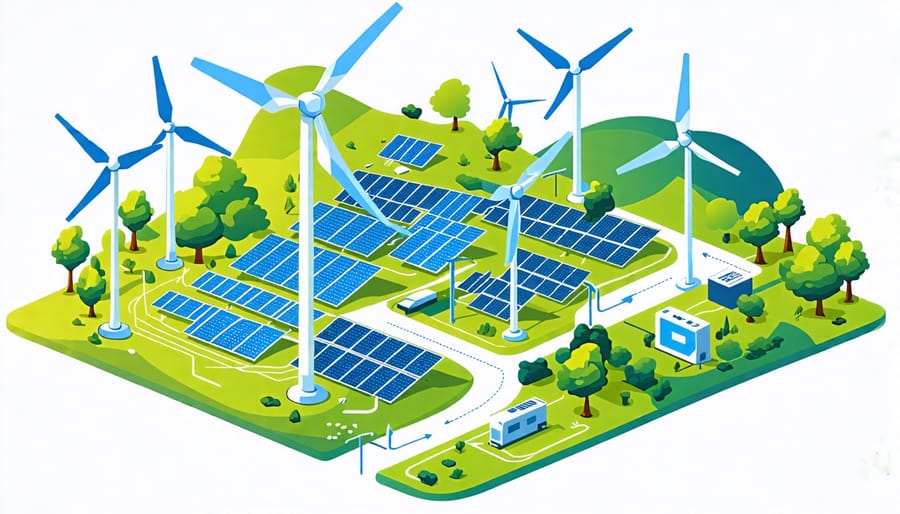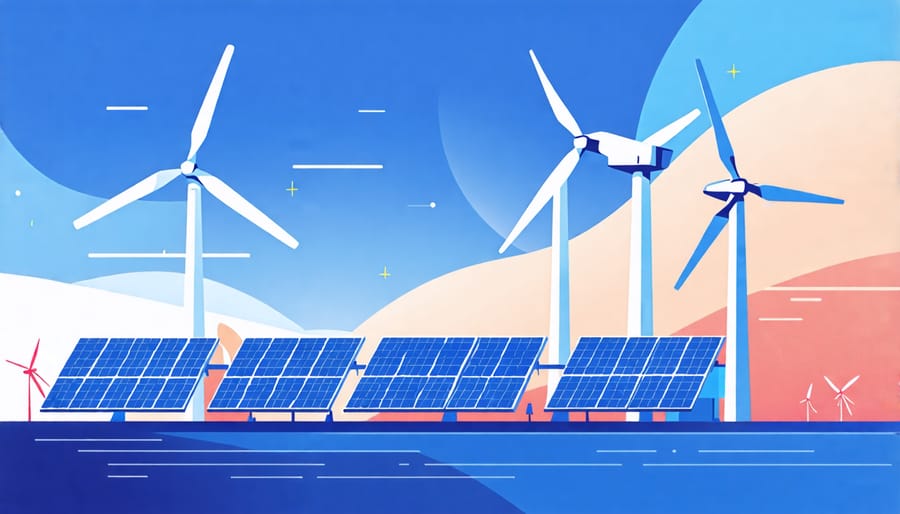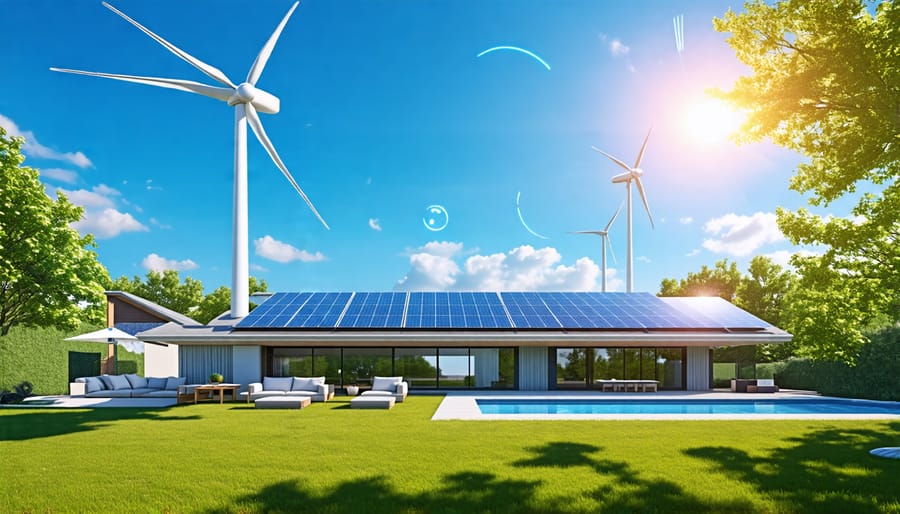Consider installing a solar and wind hybrid system to achieve sustainable energy independence at home. Assess your energy needs and local weather patterns to determine the right balance of solar panels and wind turbines. Compare options by examining a solar and wind comparison to choose complementary technologies. Engage with local renewable energy experts to understand installation processes and ensure optimal placement for maximum efficiency. Research available incentives and rebates that can offset initial costs, making your transition to green energy more affordable.
Understanding the Components and Functionality


Solar Panels and Wind Turbines: The Power Duo
In a solar and wind hybrid system, solar panels and wind turbines work harmoniously to create a more reliable and efficient energy solution for homes. Solar panels harness sunlight, converting it directly into electricity using photovoltaic cells. This process is most effective during sunny days, providing a consistent power source. Meanwhile, wind turbines take advantage of windy conditions, converting kinetic energy from the wind into electricity. These two technologies complement each other beautifully; when one source is less active, the other often picks up the slack, ensuring energy production around the clock. This synergy not only maximizes energy capture in varying weather conditions but also reduces reliance on traditional power grids, offering homeowners a sustainable and economical electricity solution. By leveraging both sun and wind, a hybrid system can provide a stable, renewable energy supply, enhancing energy independence and fostering a greener environment, perfectly aligning with the goals of eco-conscious individuals seeking to reduce their carbon footprint.
Inverters and Battery Storage
Inverters and battery storage play a crucial role in harnessing the full potential of a solar and wind hybrid system for home use. Inverters are responsible for converting the direct current (DC) generated by solar panels and wind turbines into alternating current (AC), which powers most household appliances. This conversion is essential for ensuring that the energy harnessed from renewable sources is usable and efficient, promoting a sustainable lifestyle.
Battery storage, on the other hand, addresses the intermittent nature of solar and wind energy. By storing excess energy, batteries provide a reliable power supply when the sun isn’t shining or the wind isn’t blowing. This capability not only ensures energy availability at all times but also enables homeowners to manage their energy consumption effectively, reducing dependency on the grid.
Real-life examples, such as homes in rural areas or those prone to power outages, illustrate how inverters and battery storage offer independence and stability, making hybrid systems a practical and sustainable choice for environmentally conscious individuals.
Advantages of Hybrid Systems for Home Use
Maximizing Energy Output
Embracing a solar and wind hybrid system for home use offers a compelling way to maximize energy output by tapping into two complementary sources of renewable energy. These systems work synergistically to generate power more consistently than standalone solar or wind setups. During sunny days, solar panels efficiently harness sunlight, while wind turbines pick up the slack during windy conditions, often at night or in overcast weather. This hybrid approach ensures that homeowners can rely on a stable energy supply throughout different times of the day and varying weather conditions.
The continuous energy production provided by hybrid systems directly translates into significant cost savings, minimizing dependence on traditional power grids and reducing electricity bills. Additionally, these systems foster a smaller carbon footprint, aligning perfectly with the environmental values of many enthusiasts and policy-makers advocating for sustainable solutions.
By analyzing real-life case studies, we find inspiring examples of homeowners who’ve effectively leveraged hybrid systems, transforming their homes into self-sustaining hubs of renewable energy. Such examples represent a bright path forward, proving the feasibility and benefits of solar and wind hybrid systems in everyday domestic settings.
Environmental Impact and Sustainability
Solar and wind hybrid systems significantly reduce the carbon footprint of a household by effectively harnessing natural resources to produce clean energy. These systems combine the strengths of both solar panels and wind turbines, ensuring a reliable and sustainable power supply throughout the year. By relying on renewable energy, these hybrid systems diminish the reliance on fossil fuels, leading to lower emissions of greenhouse gases that contribute to climate change. As a testament to their environmental benefits, many homeowners have reported a considerable decrease in their energy bills and a positive impact on their ecological footprint. These systems not only benefit the environment but also offer a resilient solution to potential power outages and fluctuating electricity costs. For those committed to sustainability, investing in a solar and wind hybrid system is a compelling step toward contributing to a greener planet, providing a powerful example of how individual actions can lead to meaningful environmental progress.

Choosing and Installing a Hybrid System: Practical Considerations
Assessing Your Home’s Energy Needs
To determine the appropriate size for your solar and wind hybrid system, start by reviewing your home’s energy consumption. Analyze your utility bills to understand your average monthly usage in kilowatt-hours (kWh), considering seasonal variations. Look for patterns that might indicate peaks in energy use, such as during winter heating or summer cooling. Factor in future changes, like adding new appliances or electric vehicles. By accurately gauging your needs, you’ll ensure your hybrid system efficiently meets demand, maximizing energy savings and minimizing environmental impact. This proactive approach supports a seamless transition to sustainable energy without compromising your lifestyle.
Installation and Maintenance
When installing a solar and wind hybrid system at home, it’s essential to find qualified installers who understand both renewable technologies. Look for certifications from reputable organizations such as the North American Board of Certified Energy Practitioners (NABCEP) or similar bodies. Proper installation ensures your home hybrid energy system operates efficiently from the start. For maintenance, regular inspections of panels and turbines are vital to sustain optimal performance. Clean components to prevent debris buildup and adopt a proactive approach with annual professional check-ups to address wear and tear, promoting long-term, efficient energy production.
Cost Considerations and Incentives
Investing in a solar and wind hybrid system for your home can offer both long-term savings and environmental benefits. Typically, the initial cost ranges from $15,000 to $30,000, depending on system size and location. However, government incentives can significantly reduce this expense. Programs like the federal Investment Tax Credit (ITC) in the U.S. may offer up to 30% off installation costs. State-specific rebates and grants can further lessen the financial burden while promoting renewable energy adoption. Many homeowners have recouped expenses in 5-10 years through energy savings and incentives, making these systems an attractive investment in sustainable living.
Real-Life Success Stories
Sarah and Tom, a couple from Colorado, transformed their off-grid mountain home into a model of sustainability with a solar and wind hybrid system. Living in an area with ample sunlight and consistent breezes, they saw a unique opportunity to harness both energy sources. Their system, consisting of 20 solar panels and a compact wind turbine, now generates all the electricity needed for their home. Installed by a local green energy company, the system has drastically reduced their carbon footprint, offsetting approximately 10 metric tons of CO2 per year. Sarah shares, “We’re not just saving money on energy bills, we’re investing in the future of our planet.”
Similarly, a community initiative in rural Vermont has seen a collective embrace of solar and wind systems. Facilitated by local government incentives and volunteer efforts, numerous residents have installed personal hybrid systems. Among them is James, a retired engineer, who finds joy in mentoring others about harnessing renewable energy. His system near the Green Mountains balances seasonal variations in solar and wind availability, providing reliable power even during winter storms. “Our community is stronger and more resilient now,” says James. These stories exemplify how integrating solar and wind energy can lead to not only environmental benefits but also engaged and empowered communities, lighting the way for others to follow.
Conclusion
In conclusion, the integration of solar and wind power in a hybrid system offers an enticing opportunity for those seeking sustainable energy solutions in their homes. These systems combine the strengths of solar and wind technologies to provide a more reliable and consistent energy supply. By harnessing the sun and wind’s natural power, homeowners can significantly reduce their carbon footprint, minimize electricity bills, and contribute positively to the environment.
Through our exploration of solar and wind hybrid systems, we’ve seen that they offer flexibility and adaptability, making them suitable for various geographic locations and weather conditions. Real-life case studies have demonstrated their effectiveness, and insights from experts suggest these systems will become increasingly viable and cost-effective as technology advances.
By considering a solar and wind hybrid system, you join a forward-thinking community committed to sustainable living. Not only do these systems provide practical benefits, but they also align with broader goals of reducing reliance on fossil fuels and combating climate change. As more people adopt these solutions, we encourage you to explore this green initiative further, take advantage of expert advice, and become part of a movement toward a cleaner, more sustainable future for our planet.





